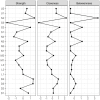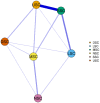Identifying central symptom clusters and correlates among post-COVID-19 pulmonary fibrosis patients: a network analysis
- PMID: 40470055
- PMCID: PMC12133559
- DOI: 10.3389/fmed.2025.1538708
Identifying central symptom clusters and correlates among post-COVID-19 pulmonary fibrosis patients: a network analysis
Abstract
Background: Previous studies have analyzed symptom clusters in patients with coronavirus disease 2019 (COVID-19); however, evidence regarding the core symptom clusters and their influencing factors in patients with post-COVID-19 pulmonary fibrosis (PCPF) remains unclear, affecting the precision of symptom interventions.
Objectives: This study aimed to identify the symptom clusters and core symptom clusters in patients with PCPF. Demographic and disease-related factors associated with these symptom clusters were also analyzed.
Methods: A total of 350 patients with PCPF were recruited from China between January 2023 and April 2024. A self-reported symptom assessment scale was used for this survey. Principal component analysis was used to identify symptom clusters. Network analysis was used to describe the relationships between the symptoms and symptom clusters. Multiple linear models were used to analyze the factors affecting the total symptom severity and each symptom cluster.
Results: Six symptom clusters were identified: Upper Respiratory Tract Symptom Cluster (USC), Lower Respiratory Tract Symptom Cluster (LSC), Somatic Symptom Cluster (SSC), Muscular and Joint Symptom Cluster (MSC), Neurological and Psychological Symptom Cluster (NSC), and Digestive Symptom Cluster (DSC). Fatigue was identified as the core and bridge symptom in the symptom network, whereas the upper respiratory symptom cluster was identified as the core and bridge symptom cluster. Gender, age, educational level, smoking history, and primary caregiver were associated with the scores of the six symptom clusters.
Conclusion: Our study suggests that there is a need to evaluate symptom clusters for the improvement of symptom management among PCPF. Specifically, the assessment and treatment of upper respiratory and fatigue symptoms as core targets of PCPF care is critical for the development of accurate and efficient symptom management strategies.
Keywords: COVID-19; interstitial; lung diseases; pulmonary fibrosis; social network analysis; syndrome.
Copyright © 2025 Yang, Xie, Wang, Yi, Chen, Du, Tao, Xie, Zhou, Zhang and He.
Conflict of interest statement
The authors declare that the research was conducted in the absence of any commercial or financial relationships that could be construed as a potential conflict of interest.
Figures









Similar articles
-
Identifying central symptom clusters and correlates in children with acute leukemia undergoing chemotherapy: a network analysis.Front Oncol. 2023 Aug 21;13:1236129. doi: 10.3389/fonc.2023.1236129. eCollection 2023. Front Oncol. 2023. PMID: 37671049 Free PMC article.
-
Identifying Symptom Clusters Among People Living With HIV on Antiretroviral Therapy in China: A Network Analysis.J Pain Symptom Manage. 2019 Mar;57(3):617-626. doi: 10.1016/j.jpainsymman.2018.11.011. Epub 2018 Nov 20. J Pain Symptom Manage. 2019. PMID: 30465875
-
Identifying core symptom clusters based on symptom distress levels in patients with maintenance hemodialysis: a cross-sectional network analysis.Ren Fail. 2025 Dec;47(1):2449203. doi: 10.1080/0886022X.2024.2449203. Epub 2025 Jan 13. Ren Fail. 2025. PMID: 39806785 Free PMC article.
-
Folic acid supplementation and malaria susceptibility and severity among people taking antifolate antimalarial drugs in endemic areas.Cochrane Database Syst Rev. 2022 Feb 1;2(2022):CD014217. doi: 10.1002/14651858.CD014217. Cochrane Database Syst Rev. 2022. PMID: 36321557 Free PMC article.
-
Post COVID-19 pulmonary fibrosis; a meta-analysis study.Ann Med Surg (Lond). 2022 May;77:103590. doi: 10.1016/j.amsu.2022.103590. Epub 2022 Apr 6. Ann Med Surg (Lond). 2022. PMID: 35411216 Free PMC article. Review.
References
-
- dashboard WC-. Number of COVID-19 cases reported to WHO. (2024). Available online at: https://data.who.int/dashboards/covid19/cases?n=c (accessed November 4, 2024).
-
- Prevention . CfDCa. COVID-19 mortality update—United States, 2022. (2023). Available online at: https://www.cdc.gov/%20mmwr/volumes/72/wr/mm7218a4.htm (accessed November 4, 2024).
LinkOut - more resources
Full Text Sources
Miscellaneous

